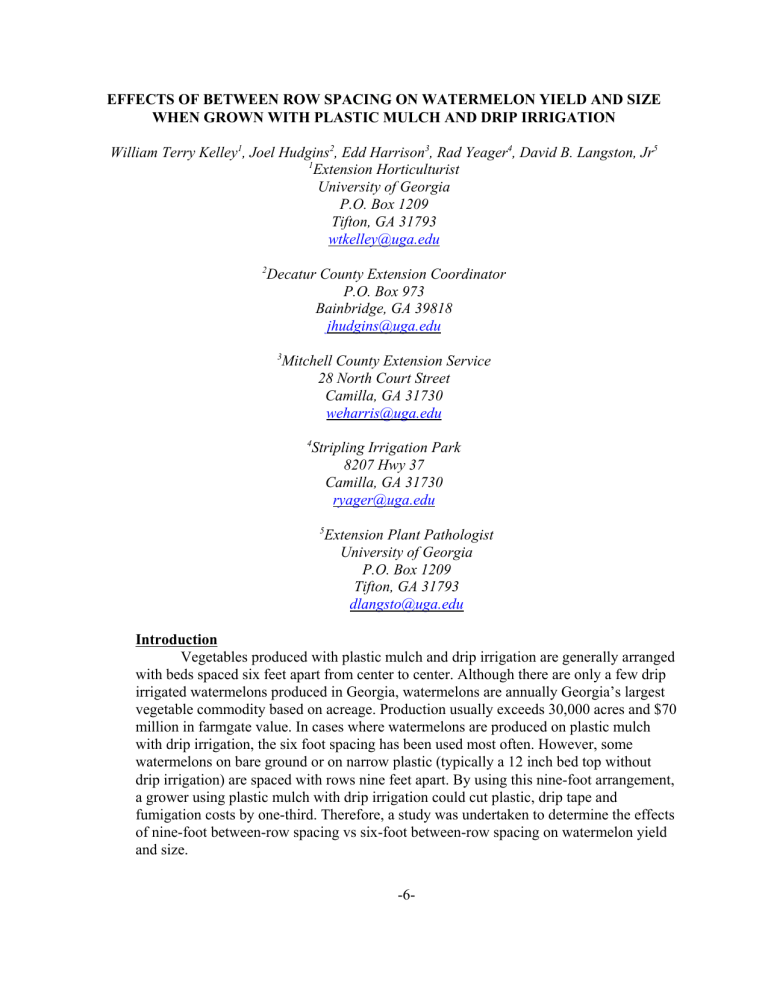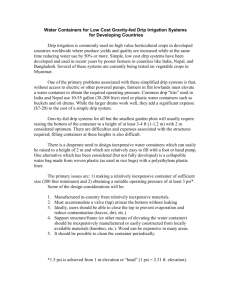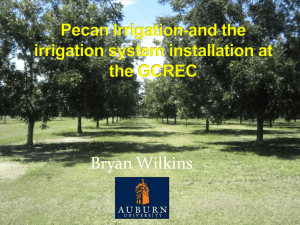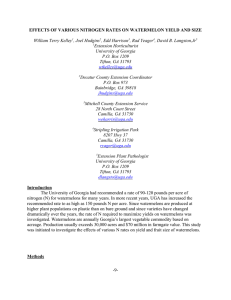EFFECTS OF BETWEEN ROW SPACING ON WATERMELON YIELD AND SIZE

EFFECTS OF BETWEEN ROW SPACING ON WATERMELON YIELD AND SIZE
WHEN GROWN WITH PLASTIC MULCH AND DRIP IRRIGATION
William Terry Kelley 1 , Joel Hudgins 2 , Edd Harrison 3 , Rad Yeager
1 Extension Horticulturist
University of Georgia
4 , David B. Langston, Jr 5
P.O. Box 1209
Tifton, GA 31793 wtkelley@uga.edu
2 Decatur County Extension Coordinator
P.O. Box 973
Bainbridge, GA 39818 jhudgins@uga.edu
3 Mitchell County Extension Service
28 North Court Street
Camilla, GA 31730 weharris@uga.edu
4 Stripling Irrigation Park
8207 Hwy 37
Camilla, GA 31730 ryager@uga.edu
5 Extension Plant Pathologist
University of Georgia
P.O. Box 1209
Tifton, GA 31793 dlangsto@uga.edu
Introduction
Vegetables produced with plastic mulch and drip irrigation are generally arranged with beds spaced six feet apart from center to center. Although there are only a few drip irrigated watermelons produced in Georgia, watermelons are annually Georgia’s largest vegetable commodity based on acreage. Production usually exceeds 30,000 acres and $70 million in farmgate value. In cases where watermelons are produced on plastic mulch with drip irrigation, the six foot spacing has been used most often. However, some watermelons on bare ground or on narrow plastic (typically a 12 inch bed top without drip irrigation) are spaced with rows nine feet apart. By using this nine-foot arrangement, a grower using plastic mulch with drip irrigation could cut plastic, drip tape and fumigation costs by one-third. Therefore, a study was undertaken to determine the effects of nine-foot between-row spacing vs six-foot between-row spacing on watermelon yield and size.
-6-
Methods
Watermelon plants (variety “Tri-X Carousel”, Syngenta Seed Co.) were produced in a greenhouse by a commercial transplant grower. Plots were established at the
Stripling Irrigation Park (elev. ~175 feet) in Camilla, GA. Plot land was tilled and 600 lb/A 10-10-10 was applied and incorporated. Methyl bromide was applied (134 lb.
a.i./acre) when black plastic mulch and drip tape were installed.
Watermelons were transplanted on April 12, 2004 into a Lucy loamy sand
(loamy, siliceous, thermic Arenic Paleudults) soil. Plots consisted of three rows (for ninefoot beds) or four rows (six-foot beds) of watermelons planted on raised beds that were spaced six feet apart (from center to center) or nine feet apart. In-row spacing was 48 inches per plant with the six-foot plots and 32 inches per plant with the nine-foot rows.
This resulted in a per plant are allocation of about 24 square feet per plant. Plots were each 30 feet long and were replicated four times. The experiment was arranged in a
Randomized Complete Block Design.
Additional fertilizer was applied through the drip irrigation system for a total of
160 pounds per acre of N and K with total P of 60 pounds per acre. Watermelons were harvested on June 24, July 1 and July 13, 2004 and data collected on yield and fruit size.
Other than plant spacing, normal cultural and pest control practices were used.
Results and Discussion
Results are presented in Table 1. There were no significant differences between melons produced on beds six feet apart and those produced nine feet apart for either yield, fruit size or fruit number per acre. These results suggest that melons can be produced on nine-foot centers with plastic mulch and drip irrigation without sacrificing yield. This would allow growers to save one-third of the cost of plastic, drip tape and fumigation materials and labor.
Table 1.
Yield, average fruit weight and number of fruit per acre of
-7-
Treatment watermelons produced with six-feet between rows and nine-feet between rows at Camilla, Georgia in 2004.
Yield Average Fruit Weight
(Lbs.) (Lbs.) r
Per Acre
Fruit
Numbe
Nine-foot centers
Six-foot centers
84,297 a
82,517 a
16.1 a
16.3 a
5246 a
5059 a
Mean
L.S.D. (0.05)
C.V. (%)
83,407
11,746
12.5
16.2
0.6
3.5
5152
763
13.1
Means within the same column followed by the same letter are not significantly different at P=0.05.
-8-





